Module 3 Journey to space模块表格式教案
文档属性
| 名称 | Module 3 Journey to space模块表格式教案 |
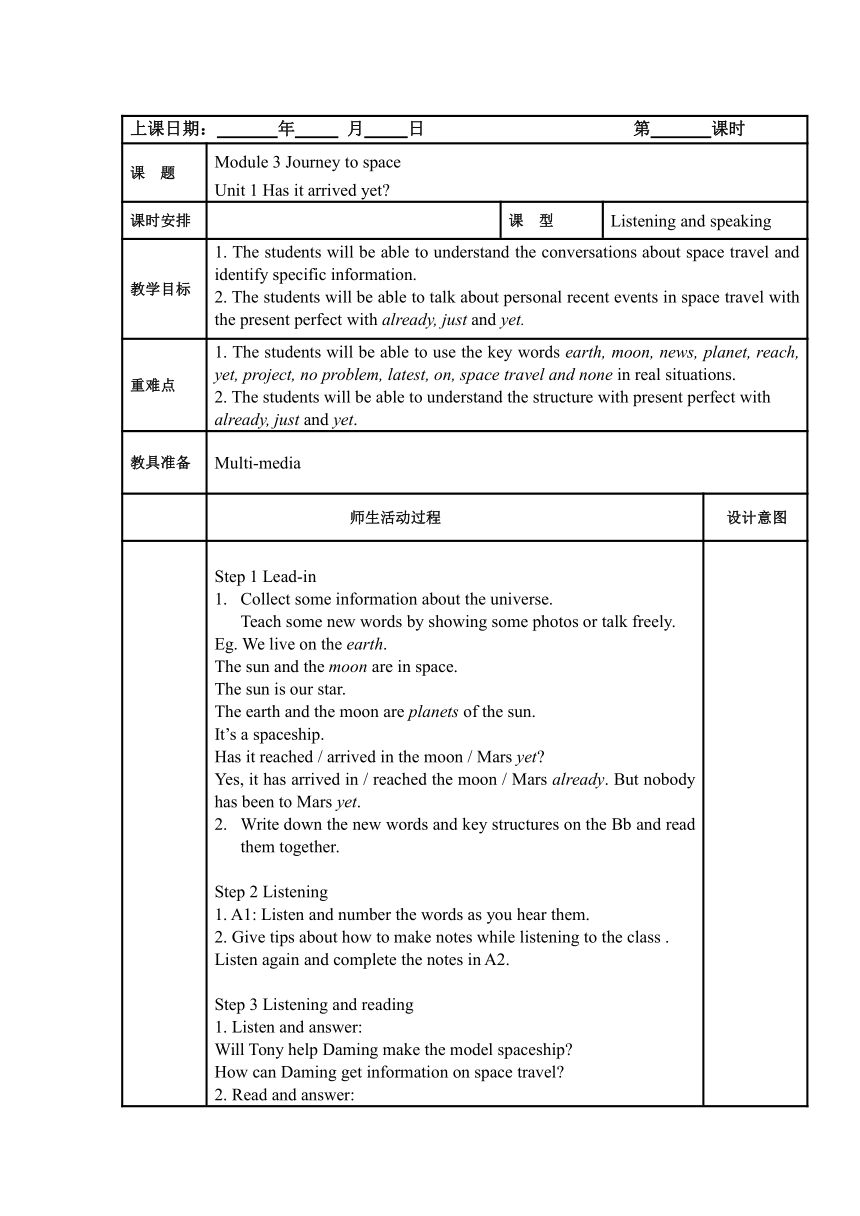
|
|
| 格式 | doc | ||
| 文件大小 | 100.0KB | ||
| 资源类型 | 教案 | ||
| 版本资源 | 外研版 | ||
| 科目 | 英语 | ||
| 更新时间 | 2023-01-10 20:18:16 | ||
图片预览

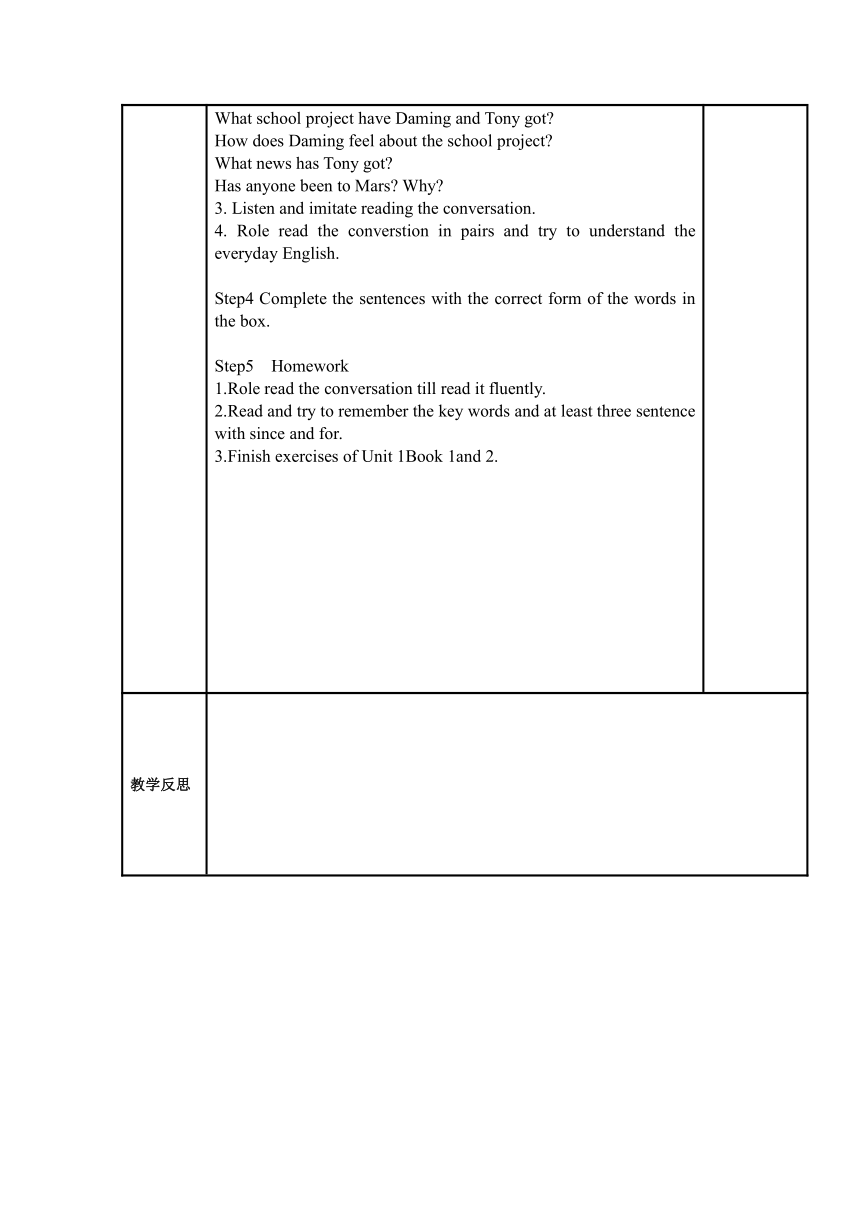
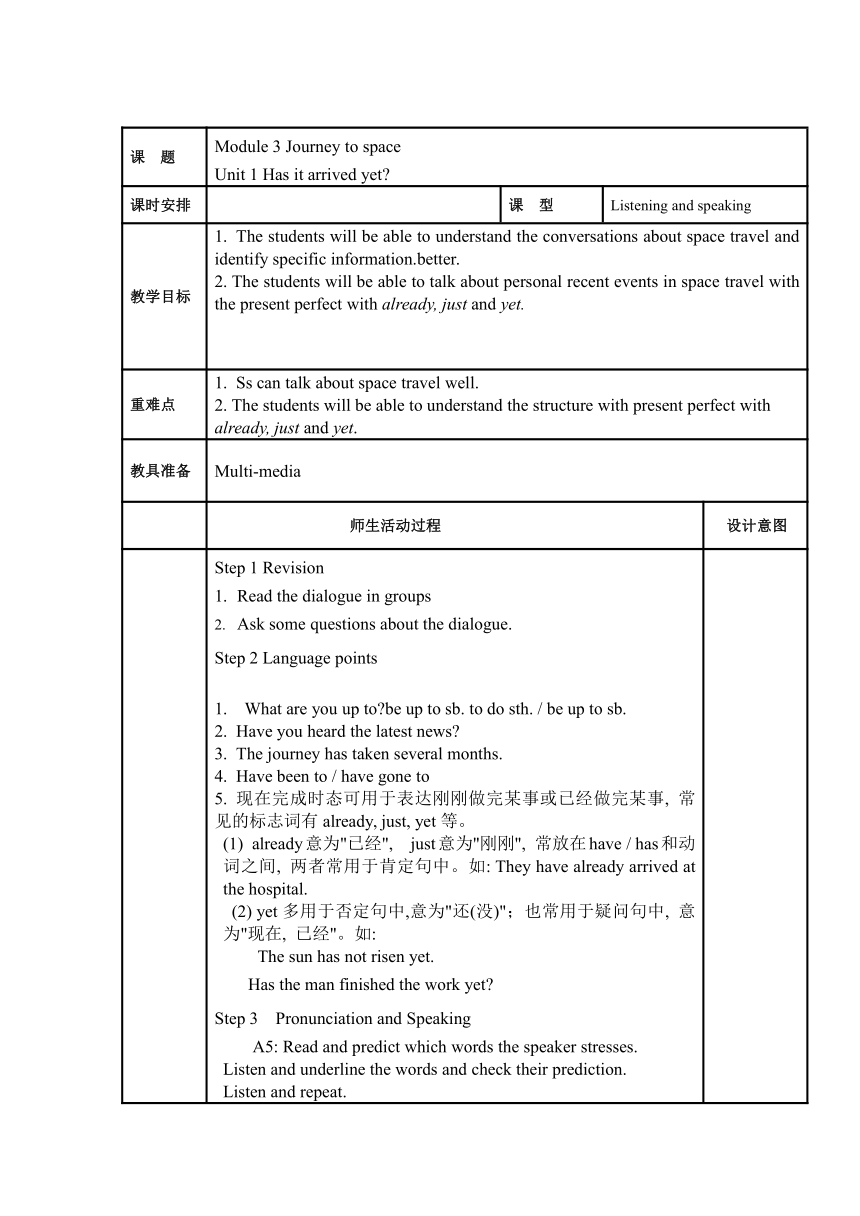
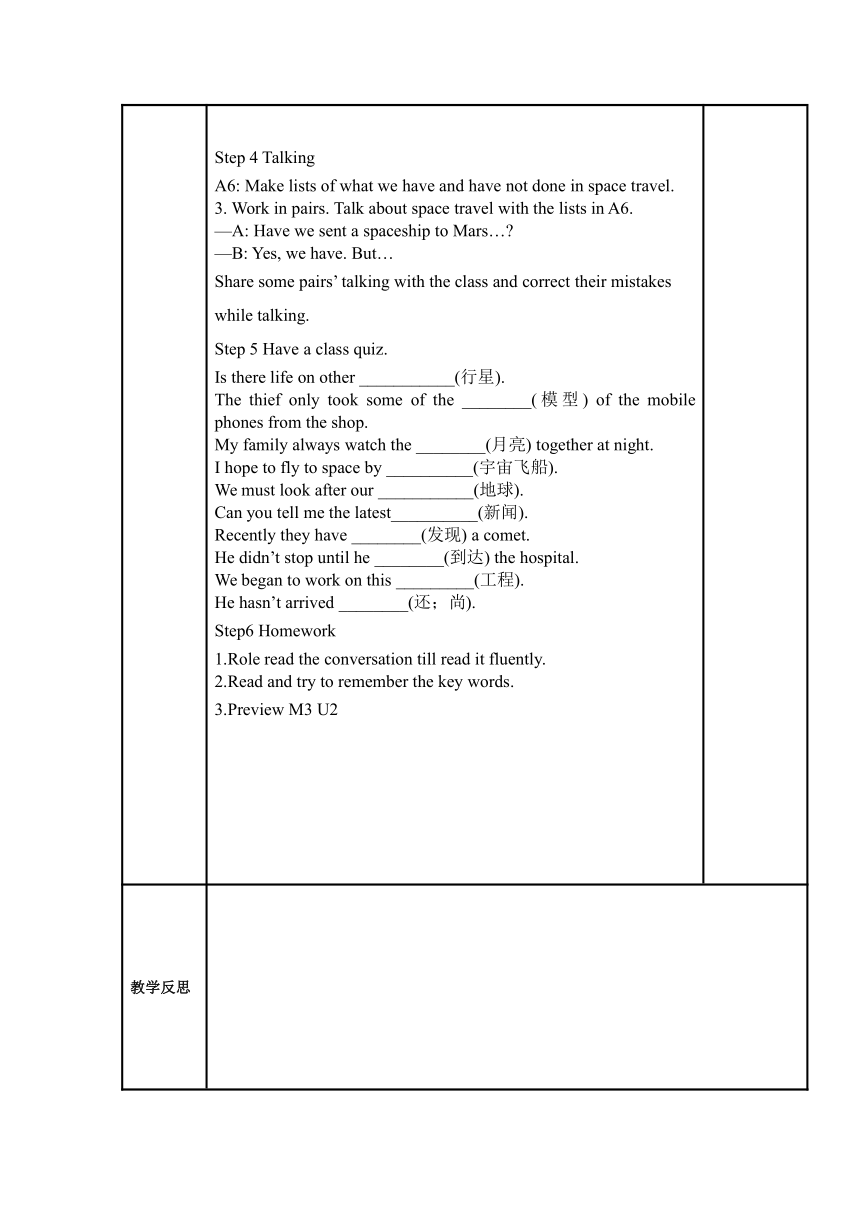
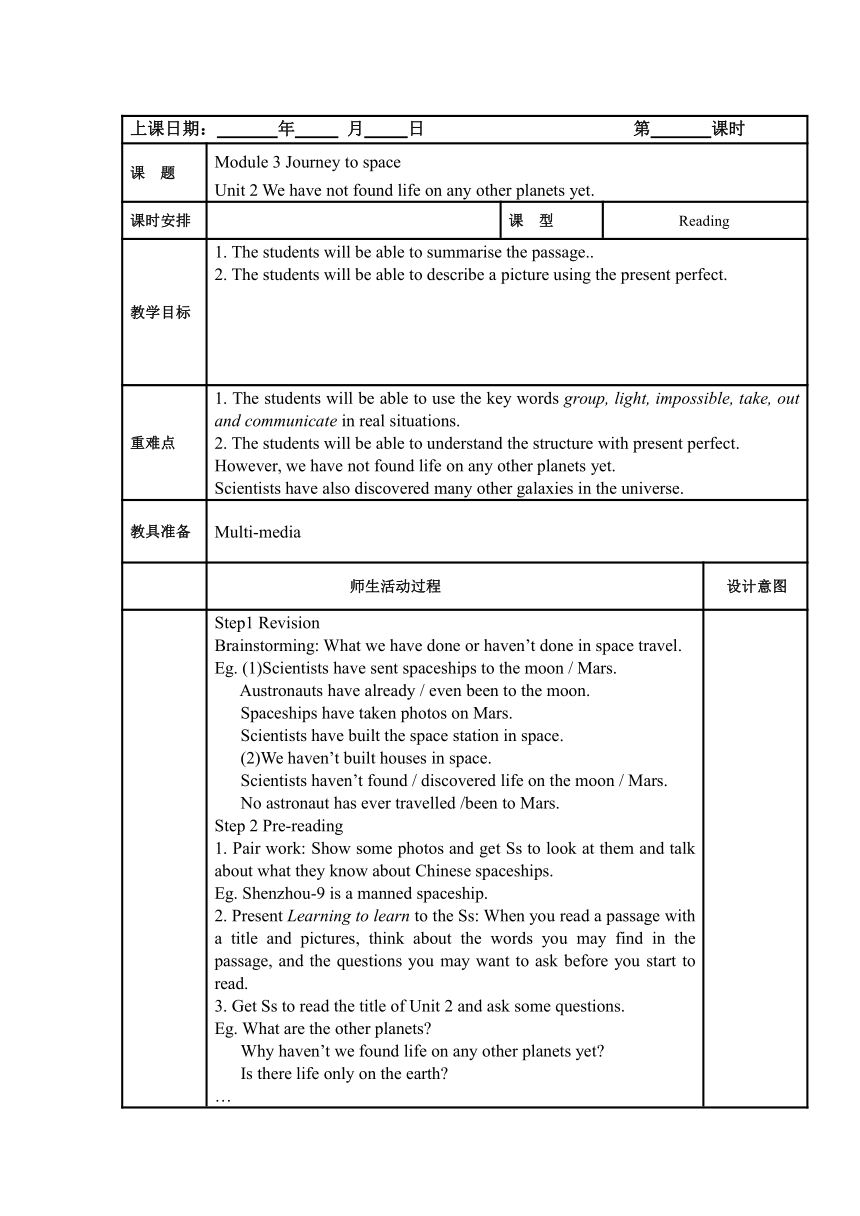
文档简介
上课日期: 年 月 日 第 课时
课 题 Module 3 Journey to spaceUnit 1 Has it arrived yet
课时安排 课 型 Listening and speaking
教学目标 1. The students will be able to understand the conversations about space travel and identify specific information.2. The students will be able to talk about personal recent events in space travel with the present perfect with already, just and yet.
重难点 1. The students will be able to use the key words earth, moon, news, planet, reach, yet, project, no problem, latest, on, space travel and none in real situations.2. The students will be able to understand the structure with present perfect with already, just and yet.
教具准备 Multi-media
师生活动过程 设计意图
Step 1 Lead-inCollect some information about the universe. Teach some new words by showing some photos or talk freely.Eg. We live on the earth. The sun and the moon are in space. The sun is our star. The earth and the moon are planets of the sun.It’s a spaceship. Has it reached / arrived in the moon / Mars yet Yes, it has arrived in / reached the moon / Mars already. But nobody has been to Mars yet.Write down the new words and key structures on the Bb and read them together.Step 2 Listening1. A1: Listen and number the words as you hear them.2. Give tips about how to make notes while listening to the class .Listen again and complete the notes in A2. Step 3 Listening and reading1. Listen and answer: Will Tony help Daming make the model spaceship How can Daming get information on space travel 2. Read and answer:What school project have Daming and Tony got How does Daming feel about the school project What news has Tony got Has anyone been to Mars Why 3. Listen and imitate reading the conversation.4. Role read the converstion in pairs and try to understand the everyday English.Step4 Complete the sentences with the correct form of the words in the box.Step5 Homework1.Role read the conversation till read it fluently.2.Read and try to remember the key words and at least three sentence with since and for.3.Finish exercises of Unit 1Book 1and 2.
教学反思
课 题 Module 3 Journey to spaceUnit 1 Has it arrived yet
课时安排 课 型 Listening and speaking
教学目标 The students will be able to understand the conversations about space travel and identify specific information.better.2. The students will be able to talk about personal recent events in space travel with the present perfect with already, just and yet.
重难点 Ss can talk about space travel well.2. The students will be able to understand the structure with present perfect with already, just and yet.
教具准备 Multi-media
师生活动过程 设计意图
Step 1 RevisionRead the dialogue in groupsAsk some questions about the dialogue.Step 2 Language points What are you up to be up to sb. to do sth. / be up to sb.Have you heard the latest news The journey has taken several months.Have been to / have gone to现在完成时态可用于表达刚刚做完某事或已经做完某事, 常见的标志词有already, just, yet等。already意为"已经", just意为"刚刚", 常放在have / has和动词之间, 两者常用于肯定句中。如: They have already arrived at the hospital. (2) yet多用于否定句中,意为"还(没)";也常用于疑问句中, 意为"现在, 已经"。如: The sun has not risen yet. Has the man finished the work yet Step 3 Pronunciation and Speaking A5: Read and predict which words the speaker stresses. Listen and underline the words and check their prediction. Listen and repeat.Step 4 TalkingA6: Make lists of what we have and have not done in space travel.3. Work in pairs. Talk about space travel with the lists in A6.—A: Have we sent a spaceship to Mars… —B: Yes, we have. But…Share some pairs’ talking with the class and correct their mistakes while talking.Step 5 Have a class quiz.Is there life on other ___________(行星).The thief only took some of the ________(模型) of the mobile phones from the shop.My family always watch the ________(月亮) together at night.I hope to fly to space by __________(宇宙飞船).We must look after our ___________(地球).Can you tell me the latest__________(新闻).Recently they have ________(发现) a comet.He didn’t stop until he ________(到达) the hospital.We began to work on this _________(工程).He hasn’t arrived ________(还;尚).Step6 Homework1.Role read the conversation till read it fluently.2.Read and try to remember the key words. 3.Preview M3 U2
教学反思
上课日期: 年 月 日 第 课时
课 题 Module 3 Journey to spaceUnit 2 We have not found life on any other planets yet.
课时安排 课 型 Reading
教学目标 1. The students will be able to summarise the passage..2. The students will be able to describe a picture using the present perfect.
重难点 1. The students will be able to use the key words group, light, impossible, take, out and communicate in real situations.2. The students will be able to understand the structure with present perfect.However, we have not found life on any other planets yet.Scientists have also discovered many other galaxies in the universe.
教具准备 Multi-media
师生活动过程 设计意图
Step1 RevisionBrainstorming: What we have done or haven’t done in space travel.Eg. (1)Scientists have sent spaceships to the moon / Mars. Austronauts have already / even been to the moon. Spaceships have taken photos on Mars. Scientists have built the space station in space. (2)We haven’t built houses in space. Scientists haven’t found / discovered life on the moon / Mars. No astronaut has ever travelled /been to Mars.Step 2 Pre-reading1. Pair work: Show some photos and get Ss to look at them and talk about what they know about Chinese spaceships.Eg. Shenzhou-9 is a manned spaceship.2. Present Learning to learn to the Ss: When you read a passage with a title and pictures, think about the words you may find in the passage, and the questions you may want to ask before you start to read.3. Get Ss to read the title of Unit 2 and ask some questions.Eg. What are the other planets Why haven’t we found life on any other planets yet Is there life only on the earth …Step 2 While reading1. Skim the passage and choose the best title for it.Para 1: …However, we have not found life on any other planets yet.The last paragraph: Scientists have always asked the questions: with so many stars in the universe, …2. Read again and check the true sentences. If the sentences are true, find the key sentences in the passage. If not, correct the false sentences.3. Read and put them in the order of the size from small to large.the earth, the universe, the solar system, the moon, the sun, the Galaxy4. Read and answer(1)What are called the solar system The earth and seven other planets.(2)What are called the Galaxy or the Milky Way A larger group of stars and planets.(3)Is it possible to imagine how large the universe is Why or Why not (4)Have any spaceships travelled to other stars in our Galaxy Step 3 Post reading1. A4: Complete the passage with the words and expressions in the box.2. Discussion:Do you think we can travel to other stars in our Galaxy one day 3.Listen and read the passage.Step 4 Homework1. Read the passage till read it fluently.2. Finish the exercises of Unit 2 in Book1,2.
教学反思
上课日期: 年 月 日 第 课时
课 题 Module 3 Journey to spaceUnit 2 We have not found life on any other planets yet.
课时安排 课 型 Writing
教学目标 1. The students will be able to summarise the passage..2. The students will be able to describe a picture using the present perfect.
重难点 1. The students will be able to understand the structure with present perfect.However, we have not found life on any other planets yet.Scientists have also discovered many other galaxies in the universe.Describe the picture and writing
教具准备 Multi-media
师生活动过程 设计意图
Step 1 RevisionRead the passage by ss themselves.Ask some questions about the passage.Step 2 Language points. … on the earth for hundreds of millions of years. it goes around the Sun. None of them has an environment …With so many stars in the universe, are we alone, or is there life out there in space Alone, lonelyStep 3 Writing 1.Look at the cartoon picture and answer the questions. In A5Where has the spaceship landed (Mars)What has the spaceship discovered (people on Mars)Why have the people on Mars not sent us a message (do not know how to)Why have the people on Mars not visited us on the earth (do not know how to) 2.Writing Write a passage to describe the picture. Step 4 Sharing and polishing1. Share one of the writings with the class. Find and correct any mistakes and give advice on how to make the writing better.2. Ask Ss to correct and rewrite their passage. Then share it with a partner to make it better.3. Show them a possible version and analyze it with the class. Encourage them to copy some sentences they think they are useful for them.Step5 Have a quiz on s.Step6 Homework1. Share the passage with more classmates to learn from each other.2.Copy the passage on the composition book.
教学反思
上课日期: 年 月 日 第 课时
课 题 Module 3 Journey to spaceUnit 3 Language in use.
课时安排 课 型 Revision and application
教学目标 The students will be able to summarize and consolidate the use of the present perfect with just, already and yet, and be able to use have been to and have gone to correctly.
重难点 The students will be able to pronounce and use the key words in M3 correctly.The students will be able to understand and use the present perfect.
教具准备 Multi-media
师生活动过程 设计意图
Step 1 Listening1. A7: Tell the Ss to look at the picture and tell what the recording may be about.2. Ask Ss to read the notes and predict what kinds of words they will need to use to complete the notes. Write their ideas on the board. For example, 1= a number; 2= a number; 3= an adjective…3. Listen and try to complete the notes.4. Allow them to compare answers with their desk partner. 5. Listen again and check the answers with the whole class.Step 2 Present perfect1. Read through the sentences in the box. Ask them to make similar sentences. Simply summarize the use of present perfect with just, already and yet.2. A1: Ask Ss to complete the news with already, just and yet.Check the answers with the class.3. A2: Ask Ss to read the example sentences carefully and make sure they understand the difference between have been to and have gone to.Underline the key words in the sentences and choose the correct answers.4. A3: Complete the sentences with the expressions in the box.Call back answers from the class and check with them.5. A4: Complete the conversation with the correct form of the verbs in brackets.Check the answers with the class and ask Ss to read them together.6.A6: Ask Ss to read through the email and make sure what kinds of words they will need to use to complete the email.Read carefully and complete the email.Step 3 Vocabulary practice 1. Listen and read the words in M3 of word and expressions.2. A8: Read through the words in the box with the class and then get Ss to complete the word map.Check the answers with the class and get Ss to add more words about space to the word map and write five sentences.A9: Complete the passage with the correct form of the words in the box.Step 4 Around the world 1. Read the passage about the names of the days of the week.2. Show more information about the names of the days of the week to the class.Step5 Homework1. Revise the key vocabulary and the use of sense verbs.2. Finish Exercise of Module3Unit 3 in Book 1,2.
教学反思
上课日期: 年 月 日 第 课时
课 题 Module 3 Journey to spaceUnit 3 Language in use.
课时安排 课 型 Revision and application
教学目标 The students will be able to summarize and consolidate the use of the present perfect with just, already and yet, and be able to use have been to and have gone to correctly.
重难点 The students will be able to pronounce and use the key words in M3 correctly.The students will be able to understand and use the present perfect.
教具准备 Multi-media
师生活动过程 设计意图
Step 1 Language points一、现在完成时态 要表达“刚刚做完某事”、“已经做完某事”时,我们同样可以用现在完成时I have just heard the news. Astronauts have already been to the Moon . We have just started to explore other planets .可以看出,just用来表示“刚刚”,already用来表示“已经”,一般置于have/has之后,两者都用于肯定句,在否定句中要用yet,表示“还未”。在现在完成时的表达中要注意have been to与have gone to的区别,前者表示“去过某地”,但现在已经回来了;而后者表示“去了某地”,现在不在这里(说话人所在地)。二、语言知识点分析:(一)短语1. no one意思是“没有人”,是两个单词,不能写成一个单词。no one=nobody,指人,不指物,作主语时,谓语动词只能是单数,不能用复数加one后面不能接of介词短语。 注意none也有“没有人”之意,而且还有“没有物”之意,不过是指三个或三个以上的人或事物。作主语时,其谓语动词用单复数形式都可以。none一般与表示范围的of介词短语连用,表示全部否定。 (二)同近义词辨析1. discover与find两者都有“发现”、“找到”之意。discover指发现客观事物的存在,发现已存在而不为人所知的事情;可指发现好事,也可指发现坏事;但用于好的事较多。 注意:discover和find意思接近,有时可互换,但在表示新发现,特别是科学上的发现时,只能用discover。2. message与information两者都有“消息”的含义,但也有明显的不同点。message是可数名词,意思有“通报、消息、音信”等。 information是不可数名词,意思是“消息,情报,通知;知识,资料”。 3. alone与lonelyalone只能用作表语,陈述一个客观事实,表示“独自一个的,单独的”。另外,alone不能用very修饰,而要说very much alone或all alone。lonely既可作表语,也可作定语,具有感彩,表示“孤独的”(指人),“偏僻的,荒凉的”(指地点)。 Step2 HomeworkRevise the key vocabulary and the language points.
教学反思
课 题 Module 3 Journey to spaceUnit 1 Has it arrived yet
课时安排 课 型 Listening and speaking
教学目标 1. The students will be able to understand the conversations about space travel and identify specific information.2. The students will be able to talk about personal recent events in space travel with the present perfect with already, just and yet.
重难点 1. The students will be able to use the key words earth, moon, news, planet, reach, yet, project, no problem, latest, on, space travel and none in real situations.2. The students will be able to understand the structure with present perfect with already, just and yet.
教具准备 Multi-media
师生活动过程 设计意图
Step 1 Lead-inCollect some information about the universe. Teach some new words by showing some photos or talk freely.Eg. We live on the earth. The sun and the moon are in space. The sun is our star. The earth and the moon are planets of the sun.It’s a spaceship. Has it reached / arrived in the moon / Mars yet Yes, it has arrived in / reached the moon / Mars already. But nobody has been to Mars yet.Write down the new words and key structures on the Bb and read them together.Step 2 Listening1. A1: Listen and number the words as you hear them.2. Give tips about how to make notes while listening to the class .Listen again and complete the notes in A2. Step 3 Listening and reading1. Listen and answer: Will Tony help Daming make the model spaceship How can Daming get information on space travel 2. Read and answer:What school project have Daming and Tony got How does Daming feel about the school project What news has Tony got Has anyone been to Mars Why 3. Listen and imitate reading the conversation.4. Role read the converstion in pairs and try to understand the everyday English.Step4 Complete the sentences with the correct form of the words in the box.Step5 Homework1.Role read the conversation till read it fluently.2.Read and try to remember the key words and at least three sentence with since and for.3.Finish exercises of Unit 1Book 1and 2.
教学反思
课 题 Module 3 Journey to spaceUnit 1 Has it arrived yet
课时安排 课 型 Listening and speaking
教学目标 The students will be able to understand the conversations about space travel and identify specific information.better.2. The students will be able to talk about personal recent events in space travel with the present perfect with already, just and yet.
重难点 Ss can talk about space travel well.2. The students will be able to understand the structure with present perfect with already, just and yet.
教具准备 Multi-media
师生活动过程 设计意图
Step 1 RevisionRead the dialogue in groupsAsk some questions about the dialogue.Step 2 Language points What are you up to be up to sb. to do sth. / be up to sb.Have you heard the latest news The journey has taken several months.Have been to / have gone to现在完成时态可用于表达刚刚做完某事或已经做完某事, 常见的标志词有already, just, yet等。already意为"已经", just意为"刚刚", 常放在have / has和动词之间, 两者常用于肯定句中。如: They have already arrived at the hospital. (2) yet多用于否定句中,意为"还(没)";也常用于疑问句中, 意为"现在, 已经"。如: The sun has not risen yet. Has the man finished the work yet Step 3 Pronunciation and Speaking A5: Read and predict which words the speaker stresses. Listen and underline the words and check their prediction. Listen and repeat.Step 4 TalkingA6: Make lists of what we have and have not done in space travel.3. Work in pairs. Talk about space travel with the lists in A6.—A: Have we sent a spaceship to Mars… —B: Yes, we have. But…Share some pairs’ talking with the class and correct their mistakes while talking.Step 5 Have a class quiz.Is there life on other ___________(行星).The thief only took some of the ________(模型) of the mobile phones from the shop.My family always watch the ________(月亮) together at night.I hope to fly to space by __________(宇宙飞船).We must look after our ___________(地球).Can you tell me the latest__________(新闻).Recently they have ________(发现) a comet.He didn’t stop until he ________(到达) the hospital.We began to work on this _________(工程).He hasn’t arrived ________(还;尚).Step6 Homework1.Role read the conversation till read it fluently.2.Read and try to remember the key words. 3.Preview M3 U2
教学反思
上课日期: 年 月 日 第 课时
课 题 Module 3 Journey to spaceUnit 2 We have not found life on any other planets yet.
课时安排 课 型 Reading
教学目标 1. The students will be able to summarise the passage..2. The students will be able to describe a picture using the present perfect.
重难点 1. The students will be able to use the key words group, light, impossible, take, out and communicate in real situations.2. The students will be able to understand the structure with present perfect.However, we have not found life on any other planets yet.Scientists have also discovered many other galaxies in the universe.
教具准备 Multi-media
师生活动过程 设计意图
Step1 RevisionBrainstorming: What we have done or haven’t done in space travel.Eg. (1)Scientists have sent spaceships to the moon / Mars. Austronauts have already / even been to the moon. Spaceships have taken photos on Mars. Scientists have built the space station in space. (2)We haven’t built houses in space. Scientists haven’t found / discovered life on the moon / Mars. No astronaut has ever travelled /been to Mars.Step 2 Pre-reading1. Pair work: Show some photos and get Ss to look at them and talk about what they know about Chinese spaceships.Eg. Shenzhou-9 is a manned spaceship.2. Present Learning to learn to the Ss: When you read a passage with a title and pictures, think about the words you may find in the passage, and the questions you may want to ask before you start to read.3. Get Ss to read the title of Unit 2 and ask some questions.Eg. What are the other planets Why haven’t we found life on any other planets yet Is there life only on the earth …Step 2 While reading1. Skim the passage and choose the best title for it.Para 1: …However, we have not found life on any other planets yet.The last paragraph: Scientists have always asked the questions: with so many stars in the universe, …2. Read again and check the true sentences. If the sentences are true, find the key sentences in the passage. If not, correct the false sentences.3. Read and put them in the order of the size from small to large.the earth, the universe, the solar system, the moon, the sun, the Galaxy4. Read and answer(1)What are called the solar system The earth and seven other planets.(2)What are called the Galaxy or the Milky Way A larger group of stars and planets.(3)Is it possible to imagine how large the universe is Why or Why not (4)Have any spaceships travelled to other stars in our Galaxy Step 3 Post reading1. A4: Complete the passage with the words and expressions in the box.2. Discussion:Do you think we can travel to other stars in our Galaxy one day 3.Listen and read the passage.Step 4 Homework1. Read the passage till read it fluently.2. Finish the exercises of Unit 2 in Book1,2.
教学反思
上课日期: 年 月 日 第 课时
课 题 Module 3 Journey to spaceUnit 2 We have not found life on any other planets yet.
课时安排 课 型 Writing
教学目标 1. The students will be able to summarise the passage..2. The students will be able to describe a picture using the present perfect.
重难点 1. The students will be able to understand the structure with present perfect.However, we have not found life on any other planets yet.Scientists have also discovered many other galaxies in the universe.Describe the picture and writing
教具准备 Multi-media
师生活动过程 设计意图
Step 1 RevisionRead the passage by ss themselves.Ask some questions about the passage.Step 2 Language points. … on the earth for hundreds of millions of years. it goes around the Sun. None of them has an environment …With so many stars in the universe, are we alone, or is there life out there in space Alone, lonelyStep 3 Writing 1.Look at the cartoon picture and answer the questions. In A5Where has the spaceship landed (Mars)What has the spaceship discovered (people on Mars)Why have the people on Mars not sent us a message (do not know how to)Why have the people on Mars not visited us on the earth (do not know how to) 2.Writing Write a passage to describe the picture. Step 4 Sharing and polishing1. Share one of the writings with the class. Find and correct any mistakes and give advice on how to make the writing better.2. Ask Ss to correct and rewrite their passage. Then share it with a partner to make it better.3. Show them a possible version and analyze it with the class. Encourage them to copy some sentences they think they are useful for them.Step5 Have a quiz on s.Step6 Homework1. Share the passage with more classmates to learn from each other.2.Copy the passage on the composition book.
教学反思
上课日期: 年 月 日 第 课时
课 题 Module 3 Journey to spaceUnit 3 Language in use.
课时安排 课 型 Revision and application
教学目标 The students will be able to summarize and consolidate the use of the present perfect with just, already and yet, and be able to use have been to and have gone to correctly.
重难点 The students will be able to pronounce and use the key words in M3 correctly.The students will be able to understand and use the present perfect.
教具准备 Multi-media
师生活动过程 设计意图
Step 1 Listening1. A7: Tell the Ss to look at the picture and tell what the recording may be about.2. Ask Ss to read the notes and predict what kinds of words they will need to use to complete the notes. Write their ideas on the board. For example, 1= a number; 2= a number; 3= an adjective…3. Listen and try to complete the notes.4. Allow them to compare answers with their desk partner. 5. Listen again and check the answers with the whole class.Step 2 Present perfect1. Read through the sentences in the box. Ask them to make similar sentences. Simply summarize the use of present perfect with just, already and yet.2. A1: Ask Ss to complete the news with already, just and yet.Check the answers with the class.3. A2: Ask Ss to read the example sentences carefully and make sure they understand the difference between have been to and have gone to.Underline the key words in the sentences and choose the correct answers.4. A3: Complete the sentences with the expressions in the box.Call back answers from the class and check with them.5. A4: Complete the conversation with the correct form of the verbs in brackets.Check the answers with the class and ask Ss to read them together.6.A6: Ask Ss to read through the email and make sure what kinds of words they will need to use to complete the email.Read carefully and complete the email.Step 3 Vocabulary practice 1. Listen and read the words in M3 of word and expressions.2. A8: Read through the words in the box with the class and then get Ss to complete the word map.Check the answers with the class and get Ss to add more words about space to the word map and write five sentences.A9: Complete the passage with the correct form of the words in the box.Step 4 Around the world 1. Read the passage about the names of the days of the week.2. Show more information about the names of the days of the week to the class.Step5 Homework1. Revise the key vocabulary and the use of sense verbs.2. Finish Exercise of Module3Unit 3 in Book 1,2.
教学反思
上课日期: 年 月 日 第 课时
课 题 Module 3 Journey to spaceUnit 3 Language in use.
课时安排 课 型 Revision and application
教学目标 The students will be able to summarize and consolidate the use of the present perfect with just, already and yet, and be able to use have been to and have gone to correctly.
重难点 The students will be able to pronounce and use the key words in M3 correctly.The students will be able to understand and use the present perfect.
教具准备 Multi-media
师生活动过程 设计意图
Step 1 Language points一、现在完成时态 要表达“刚刚做完某事”、“已经做完某事”时,我们同样可以用现在完成时I have just heard the news. Astronauts have already been to the Moon . We have just started to explore other planets .可以看出,just用来表示“刚刚”,already用来表示“已经”,一般置于have/has之后,两者都用于肯定句,在否定句中要用yet,表示“还未”。在现在完成时的表达中要注意have been to与have gone to的区别,前者表示“去过某地”,但现在已经回来了;而后者表示“去了某地”,现在不在这里(说话人所在地)。二、语言知识点分析:(一)短语1. no one意思是“没有人”,是两个单词,不能写成一个单词。no one=nobody,指人,不指物,作主语时,谓语动词只能是单数,不能用复数加one后面不能接of介词短语。 注意none也有“没有人”之意,而且还有“没有物”之意,不过是指三个或三个以上的人或事物。作主语时,其谓语动词用单复数形式都可以。none一般与表示范围的of介词短语连用,表示全部否定。 (二)同近义词辨析1. discover与find两者都有“发现”、“找到”之意。discover指发现客观事物的存在,发现已存在而不为人所知的事情;可指发现好事,也可指发现坏事;但用于好的事较多。 注意:discover和find意思接近,有时可互换,但在表示新发现,特别是科学上的发现时,只能用discover。2. message与information两者都有“消息”的含义,但也有明显的不同点。message是可数名词,意思有“通报、消息、音信”等。 information是不可数名词,意思是“消息,情报,通知;知识,资料”。 3. alone与lonelyalone只能用作表语,陈述一个客观事实,表示“独自一个的,单独的”。另外,alone不能用very修饰,而要说very much alone或all alone。lonely既可作表语,也可作定语,具有感彩,表示“孤独的”(指人),“偏僻的,荒凉的”(指地点)。 Step2 HomeworkRevise the key vocabulary and the language points.
教学反思
同课章节目录
- Module 1 Feelings and impressions
- Unit 1 It smells delicious.
- Unit 2 I feel nervous when I speak Chinese .
- Unit 3 Language in use
- Module 2 Experiences
- Unit 1 I've also entered lots of speaking competi
- Unit 2 They have seen the Pyramids.
- Unit 3 Language in use
- Module 3 Journey to space
- Unit 1 Has it arrived yet?
- Unit 2 We have not found life on any other planet
- Unit 3 Language in use
- Module 4 Seeing the docto
- Unit 1 I haven't done much exercise since I got m
- Unit 2 We have played football for a year now
- Unit 3 Language in use
- Module 5 Cartoons
- Unit 1 It's time to watch a cartoon.
- Unit 2 Tintin has been popular for over eighty yea
- Unit 3 Language in use
- Revision module A
- Module 6 Hobbies
- Unit 1 Do you collect anything ?
- Unit 2 Hobbies can make you grow as a person.
- Unit 3 Language in use
- Module 7 Summer in Los Angeles
- Unit 1 Please write to me and send me some photos
- Unit 2 Fill out a form and come to learn English
- Unit 3 Language in use
- Module 8 Time off
- Unit 1 I can hardly believe we are in the city ce
- Unit 2 We thought somebody was moving about
- Unit 3 Language in use
- Module 9 Friendship
- Unit 1 Could I ask if you've mentioned this to he
- Unit 2 I believe that the world is what you think
- Unit 3 Language in use
- Module 10 On the radio
- Unit 1 I hope that you can join us one day
- Unit 2 It seemed that they were speaking to me in
- Unit 3 Language in use
- Revision module B
